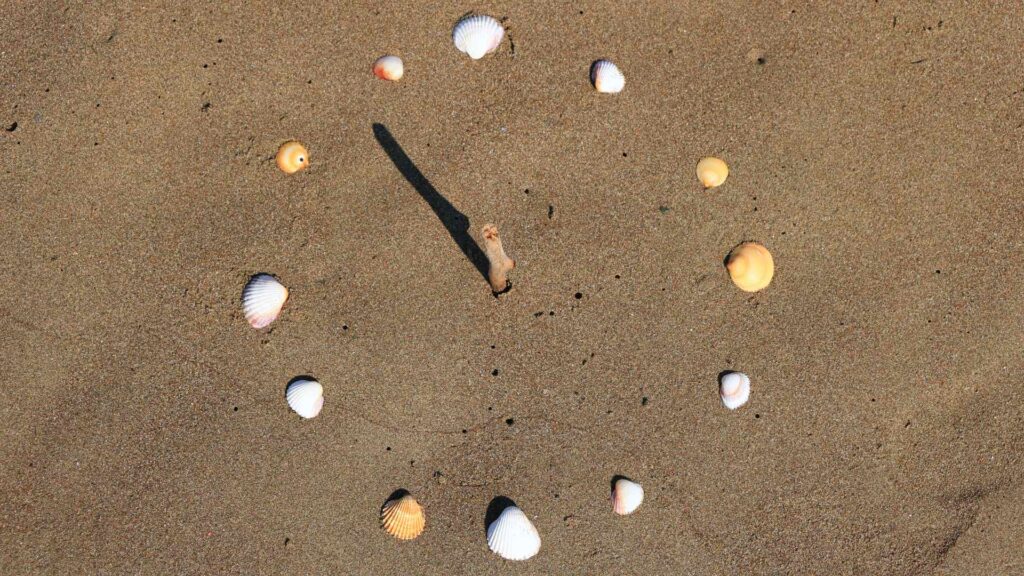Discover the fun and educational world of sundials with your kids!
Learn how to make, set up, and use a sundial to teach time-telling and explore science together.
Understanding Sundials
What is a Sundial?
A sundial is a simple yet fascinating device that tells time by using the position of the sun.
Sundials have been used for thousands of years, dating back to ancient civilizations like the Egyptians and Greeks.
They work by casting a shadow with a stick, called a gnomon, onto a flat surface marked with hour lines.
- Definition and Basic Principles: A sundial measures time by the shadow cast by its gnomon. As the sun moves across the sky, the shadow moves, indicating the time of day.
- Historical Significance: Sundials were one of the earliest tools humans used to track time. They were vital for agriculture, navigation, and daily life before mechanical clocks were invented.
How Sundials Work
Understanding how sundials work can be a fascinating journey into the basics of astronomy and Earth’s rotation.
- The Gnomon: The gnomon is the part of the sundial that casts a shadow. It is typically a stick or a rod that is positioned vertically or at an angle.
- Tip: When building a sundial, the gnomon must be positioned accurately to cast the correct shadow for time-telling.
- The Shadow and Time: As the Earth rotates, the position of the sun changes, causing the shadow of the gnomon to move. This movement of the shadow can be used to mark the hours of the day.
- Sun’s Position and Time of Day: The sun rises in the east and sets in the west. At midday, when the sun is at its highest point, the shadow will be at its shortest and will point directly north in the northern hemisphere.
- Fun Fact: The word “gnomon” comes from the Greek word for “indicator” or “one who knows.”
Historical Significance of Sundials
- Ancient Civilizations: Sundials were used by ancient Egyptians, Greeks, Romans, and Chinese. They were crucial for developing early timekeeping methods.
- Evolution Over Time: As time progressed, sundials became more sophisticated. They were used in various forms, from simple stick-and-shadow models to elaborate architectural designs.
- Cultural Importance: In many cultures, sundials were not only practical devices but also symbols of knowledge and scientific advancement.
Why Sundials Are Still Relevant
Despite the prevalence of digital clocks, sundials offer unique educational and experiential value.
- Educational Tool: Sundials provide a hands-on way for kids to learn about the Earth’s rotation, the movement of the sun, and the concept of time.
- Outdoor Activity: Building and using a sundial encourages kids to spend time outdoors, observing nature and engaging in physical activity.
- Connection to History: Creating and using a sundial connects kids to historical practices and the ingenuity of ancient civilizations.
By understanding the basics of what sundials are and how they work, you and your kids are ready to dive into the fun and educational process of making your own sundial.
This hands-on project will not only teach time-telling but also spark curiosity about the natural world and our place in it.

Preparing to Make a Sundial
Before diving into the construction of your sundial, it’s essential to gather the necessary materials and choose the right location to ensure accurate timekeeping.
Materials Needed
To build a basic sundial, you will need:
- Stick or Rod: For the gnomon that casts the shadow.
- Flat Surface: Such as a paper plate, wooden board, or flat ground.
- Markers or Paint: To mark the hour lines and decorate.
- Compass: To find the cardinal directions (north, south, east, west).
- Ruler or Measuring Tape: For precise measurements.
- Optional: Decorative items like stickers or colored tape to personalize your sundial.
Alternative Materials and Creative Options
If you want to get creative or make a more durable sundial, consider:
- Stones or Bricks: Create a permanent sundial by arranging stones or bricks in a circular pattern and using a central gnomon.
- Upcycled Materials: Use recycled materials like old CDs, pizza boxes, or metal trays for the base.
- Craft Supplies: Glue, scissors, and other craft materials to enhance the aesthetic appeal.
Choosing the Right Location
Selecting the correct location is crucial for the functionality of your sundial:
- Direct Sunlight: Ensure the chosen spot receives direct sunlight throughout the day, especially during peak hours (10 am to 2 pm).
- Clear Area: Clear any obstructions such as trees or buildings that could block the sun’s path and cast shadows on your sundial.
- Level Ground: The surface where you place your sundial should be flat and stable to prevent it from tilting or shifting.
By preparing these materials and selecting an ideal location, you set the stage for successfully building and using your sundial. Next, we’ll delve into step-by-step instructions on how to construct different types of sundials, each suitable for various skill levels and preferences.

Building Your Sundial
Now that you have gathered your materials and chosen the perfect location, it’s time to construct your sundial.
Below, we provide step-by-step instructions for creating two types of sundials: a simple ground sundial using a stick and a more decorative paper plate sundial.
Simple Ground Sundial Using a Stick
- Find a Sunny Spot: Choose a location that receives direct sunlight for most of the day.
- Insert the Stick: Place a straight stick vertically into the ground. This stick will act as your gnomon.
- Mark the Hour Lines: Throughout the day, observe where the shadow falls from the stick onto the ground. Mark these positions at regular intervals (every hour) with stones or by drawing lines.
- Label the Hour Marks: Using markers or paint, label each hour mark from morning to afternoon.
- Adjust as Needed: As the seasons change, you may need to adjust the angle of the stick slightly to maintain accuracy.
Paper Plate Sundial
- Prepare the Paper Plate: Lay out a paper plate on a flat surface. This will serve as the base of your sundial.
- Mark the Center: Find the center of the paper plate and mark it clearly.
- Position the Gnomon: Stand a stick or rod upright at the center of the plate. This will be your gnomon.
- Mark the Hour Lines: Throughout the day, observe where the shadow of the gnomon falls onto the plate. Mark these positions at regular intervals, aligning them with the hours of the day.
- Decorate Your Sundial: Use markers, stickers, or paint to decorate the paper plate sundial. You can add numbers, designs, or personalize it according to your creativity.
Creating a Permanent Sundial with Stones or Bricks
- Choose a Circular Area: Select a flat, open area in your yard or garden.
- Arrange Stones or Bricks: Arrange stones or bricks in a circular pattern, leaving a space in the center for the gnomon.
- Position the Gnomon: Place a vertical stick or rod in the center of the circle. Ensure it is firmly fixed and straight.
- Mark the Hour Lines: Similar to the other sundials, mark the positions where the shadow falls at different times of the day.
- Enhance and Decorate: If desired, decorate the stones or bricks with paint or designs. Make the sundial visually appealing while ensuring clarity in hour markings.
By following these step-by-step instructions, you and your kids can create a functional and visually appealing sundial. The next step will be to set up your sundial accurately and mark the hours to begin telling time using this ancient method of timekeeping.
Setting Up Your Sundial
After constructing your sundial, the next crucial step is to set it up correctly for accurate timekeeping. This involves aligning the sundial, marking the hour lines, and ensuring it is positioned in an optimal location.
Aligning Your Sundial
- Find True North: Use a compass to determine the direction of true north.
- Tip: Magnetic north may differ from true north due to magnetic declination, so adjust accordingly.
- Positioning the Gnomon: Ensure the gnomon (the stick or rod casting the shadow) is aligned north-south. The shadow should move in a straight line throughout the day.
- Adjust for Latitude: Depending on your geographical location, adjust the angle of the gnomon to match your latitude. For example:
- In northern latitudes, the gnomon should be more upright (closer to vertical).
- In equatorial regions, the gnomon will be almost parallel to the ground.
Marking the Hours
- Observing the Shadow: Throughout the day, observe where the shadow falls on the sundial’s surface.
- Note: The shadow will move clockwise in the northern hemisphere and counterclockwise in the southern hemisphere.
- Drawing Hour Lines: Using a marker or paint, mark the positions where the shadow falls at different times of the day.
- Start with the noon mark, which will be directly aligned with the gnomon’s shadow at midday.
- Then, mark the morning and afternoon hours accordingly, ensuring equal spacing between each hour line.
- Labeling the Hours: Once the hour lines are marked, label each line with the corresponding hour of the day (e.g., 8 AM, 9 AM, etc.).
Fine-Tuning and Testing
- Checking for Accuracy: After marking the hours, test the sundial’s accuracy by comparing its readings with a reliable clock or watch.
- Making Adjustments: If necessary, adjust the position or angle of the gnomon slightly to improve accuracy.
- Tip: Small adjustments may be needed over time due to seasonal changes in the sun’s position.
- Seasonal Considerations: Be aware that the sun’s path changes slightly throughout the year due to the tilt of the Earth’s axis. Your sundial may require seasonal adjustments to maintain accuracy.
By carefully aligning your sundial and marking the hours accurately, you and your kids can begin using this ancient timekeeping device to tell time based on the movement of the sun.
Next, we’ll explore how to read and interpret the time shown by your sundial, turning this hands-on project into a practical learning experience.

Telling Time with Your Sundial
Now that your sundial is set up and aligned, it’s time to learn how to read and interpret the time using this ancient timekeeping device.
Below, we’ll guide you through the process of telling time with your sundial and provide tips for accurate readings.
How to Read a Sundial
- Observing the Shadow: Throughout the day, observe where the shadow of the gnomon falls on the sundial’s surface.
- The shadow will move as the sun changes its position in the sky.
- Interpreting the Hour Lines: Each marked hour line corresponds to a specific time of day.
- Tip: Noon (midday) is typically marked by the shortest shadow when the sun is at its highest point in the sky.
- Accounting for Daylight Hours: Keep in mind that the length of daylight hours changes throughout the year due to seasonal variations.
- Adjustments may be needed for accurate time readings during different seasons.
Understanding Time Telling with a Sundial
- Morning and Afternoon Hours: As the sun rises in the east and sets in the west, the shadow will move accordingly.
- In the morning, the shadow will point towards the west.
- In the afternoon, the shadow will shift towards the east.
- Accuracy and Calibration: Regularly check and calibrate your sundial for accuracy.
- Ensure the gnomon remains straight and the hour lines are clear and correctly spaced.
Practicing Time-Telling
- Engage in Activities: Use the sundial as a practical tool for daily activities such as scheduling outdoor playtime or meal breaks.
- Encourage kids to predict and verify the time using the sundial.
- Educational Games: Create fun games and challenges to enhance time-telling skills using the sundial.
- Challenge kids to estimate the time based on the position of the shadow.
Tips for Using Your Sundial
- Consistent Observation: To improve accuracy, check the time on your sundial at various points throughout the day.
- Note any discrepancies and adjust if necessary.
- Seasonal Adjustments: Be aware of seasonal changes that may affect the position of the sun and the accuracy of your sundial.
- Make seasonal adjustments by slightly tilting or repositioning the gnomon.
By practicing these techniques and engaging in regular observation, you and your kids can master the art of time-telling with a sundial. This hands-on experience not only teaches practical skills but also fosters a deeper understanding of astronomy and the natural world.
Educational Benefits of Sundials
Using a sundial goes beyond just telling time; it offers numerous educational opportunities for children. Here’s how engaging with sundials can enhance learning and curiosity:
Learning Opportunities
- Understanding Solar Motion: Sundials teach kids about the Earth’s rotation and the apparent motion of the sun across the sky.
- Explore concepts like the sun’s daily path and its changing position throughout the year.
- Hands-on Astronomy: Sundials provide a tangible way to learn basic astronomy principles.
- Discuss topics such as celestial navigation, equinoxes, and solstices.
Outdoor Learning
- Encouraging Outdoor Exploration: Building and using a sundial encourages children to spend time outdoors, observing nature and the changing environment.
- Foster appreciation for the natural world and its rhythms.
- Physical and Cognitive Development: Engaging with a sundial involves physical activity (setting up the sundial, observing the sun’s movement) and cognitive skills (analyzing patterns, making predictions).
Connection to Curriculum
- STEM Integration: Sundials integrate well with STEM (Science, Technology, Engineering, and Mathematics) education.
- Align activities with school curriculum, covering topics in physics, geography, and history.
- Cross-disciplinary Learning: Explore interdisciplinary connections by discussing the historical, cultural, and mathematical aspects of sundials.
Practical Applications
- Life Skills: Learning to tell time using a sundial enhances practical time-telling skills.
- Apply time-telling skills to daily routines and activities.
- Problem-Solving: Encourage critical thinking and problem-solving skills by adjusting the sundial for accuracy.
- Discuss factors affecting the sundial’s performance, such as location and weather conditions.
By incorporating sundials into learning activities, children not only develop essential academic skills but also cultivate a deeper appreciation for science and the natural world around them.
Next, we’ll explore advanced sundial projects that build on these foundational concepts, offering opportunities for further exploration and creativity.

Advanced Sundial Projects
For those looking to delve deeper into the world of sundials, advanced projects offer opportunities to explore different designs and functionalities. Here are some exciting projects to consider:
Making a Sundial Compass
- Combining Sundial with Compass: Create a sundial compass by integrating a compass with a traditional sundial design.
- Use the compass to align the sundial precisely to true north, enhancing accuracy.
- Navigation Tool: Discuss how sundial compasses were historically used for navigation and exploration.
- Explore concepts like latitude and longitude in relation to navigation.
Sundial Variations
- Horizontal vs. Vertical Sundials: Experiment with different orientations of sundials to observe how the angle affects shadow movement.
- Compare and contrast horizontal and vertical sundials in terms of design and functionality.
- Equatorial Sundials: Explore the design principles behind equatorial sundials, which are aligned parallel to the Earth’s equator.
- Discuss their advantages for accurate time-telling throughout the year.
Experimenting with Different Gnomon Designs
- Alternative Gnomon Materials: Use different materials for the gnomon (such as metal, wood, or even plants) to observe their effects on shadow casting.
- Discuss how the shape and material of the gnomon impact the clarity and movement of the shadow.
- Adjusting Gnomon Angle: Explore how adjusting the angle of the gnomon affects the sundial’s accuracy.
- Experiment with different angles and observe changes in shadow length and position.
Advanced Decoration and Customization
- Elaborate Designs: Create intricate designs or patterns on the sundial’s surface using advanced painting techniques or mosaic work.
- Incorporate artistic elements while maintaining clarity in hour markings.
- Interactive Elements: Integrate interactive features such as movable components or digital enhancements (e.g., QR codes linking to educational content) to modernize the sundial experience.
- Combine traditional craftsmanship with contemporary technology for a unique learning experience.
Practical Applications and Challenges
- Real-World Applications: Discuss real-world applications of advanced sundial designs in modern architecture, urban planning, and scientific research.
- Explore how sundials are used in different cultures and disciplines today.
- Solving Challenges: Challenge students to identify and solve technical challenges encountered during advanced sundial projects.
- Foster creativity and innovation through problem-solving exercises.
By exploring these advanced sundial projects, children can deepen their understanding of astronomy, geometry, and historical innovation. These projects not only stimulate curiosity but also encourage creativity and critical thinking in young learners.
Troubleshooting and Common Issues
While building and using a sundial can be a rewarding experience, there are common challenges and issues that may arise.
Here’s how to troubleshoot and overcome them to ensure your sundial functions accurately:
Addressing Common Problems
- Inaccurate Time Readings:
- Cause: Incorrect alignment or positioning of the gnomon.
- Solution: Re-align the gnomon to true north using a compass. Ensure it is perpendicular to the sundial surface.
- Shadow Visibility Issues:
- Cause: Obstructions like trees, buildings, or shadows from nearby objects.
- Solution: Relocate the sundial to a spot with clearer, uninterrupted sunlight throughout the day.
Tips for Improving Accuracy
- Fine-Tuning the Gnomon Position:
- Adjust the gnomon’s angle slightly, especially during seasonal changes, to maintain accurate time readings.
- Optimizing Geographic Location:
- Consider the latitude and longitude of your location when setting up the sundial. Adjustments may be necessary based on your geographical position.
Seasonal Adjustments
- Daylight Saving Time (DST):
- During DST changes, adjust the hour markings accordingly on your sundial to reflect the new time.
- Weather Considerations:
- Weather conditions such as clouds or precipitation can affect the visibility of the shadow. Monitor these factors and adjust usage accordingly.
Maintaining Your Sundial
- Regular Inspection:
- Periodically check the sundial for any signs of wear or damage. Repair or replace parts as needed to ensure continued functionality.
- Cleaning and Care:
- Keep the sundial clean from debris or dirt that may obstruct the shadow. Use a soft cloth or brush to gently clean the surface.
Educational Opportunity
- Learning from Challenges:
- Encourage children to analyze and troubleshoot sundial issues as part of their learning experience.
- Critical Thinking Skills:
- Foster problem-solving skills by discussing possible solutions and experimenting with adjustments to improve sundial accuracy.
By understanding these troubleshooting tips and common issues, you can enhance the functionality and educational value of your sundial project.
Embrace challenges as opportunities for learning and discovery, turning each adjustment into a valuable teaching moment for children.
Fun Facts and Historical Tidbits About Sundials
Exploring sundials unveils fascinating facts and historical anecdotes that showcase their cultural significance and scientific evolution over centuries:
Interesting Facts About Sundials
- Ancient Timekeeping: Sundials are one of the oldest known timekeeping devices, dating back to ancient civilizations such as the Egyptians and Babylonians.
- Global Presence: Sundials have been found in various forms across different cultures worldwide, each reflecting unique design principles and cultural influences.
- Precision Engineering: Some ancient sundials were remarkably precise, indicating the technological advancements of their time despite their apparent simplicity.
Famous Sundials Around the World
- The Sundial of Ahaz: Located in Jerusalem, this ancient sundial is mentioned in the biblical book of Isaiah, reflecting its historical and cultural significance.
- Sun Clock Tower in Jaipur: This monumental sundial in India, built in the 18th century, is one of the largest sundials globally, showcasing intricate craftsmanship and architectural prowess.
Sundials in Different Cultures and Eras
- Chinese Sundials: Ancient Chinese sundials, known as “simplified armillary spheres,” played a crucial role in astronomy and timekeeping practices.
- Islamic Sundials: Islamic scholars made significant advancements in sundial design, incorporating mathematical precision and artistic elegance into their constructions.
Quirky Sundial Trivia
- Human Sundials: In some educational settings, human sundials involve people acting as the gnomon, casting shadows that indicate the time of day.
- Sundials in Space: Sundials have been used in space missions to study the effects of zero gravity on timekeeping and orientation.
Sundial Art and Literature
- Literary References: Sundials have inspired poets, writers, and artists throughout history, symbolizing the passage of time and humanity’s relationship with the cosmos.
- Modern Interpretations: Contemporary artists and designers continue to create innovative sundial installations that blend artistry with scientific principles.
Conclusion
Exploring the rich history and diverse cultural legacy of sundials offers a captivating journey into the intersection of science, art, and human ingenuity.
By appreciating these historical tidbits and fun facts, you and your children can deepen your understanding of how sundials have shaped civilizations and continue to inspire curiosity about time and the natural world.


